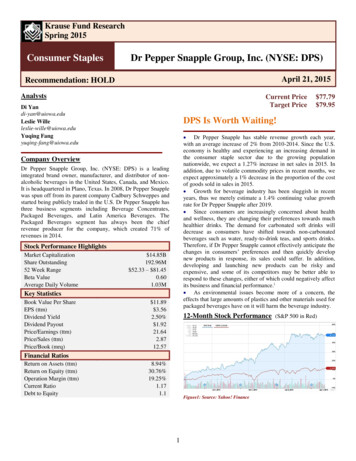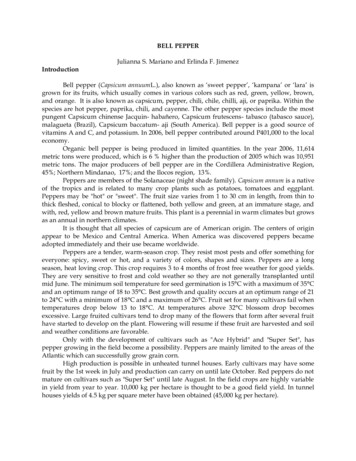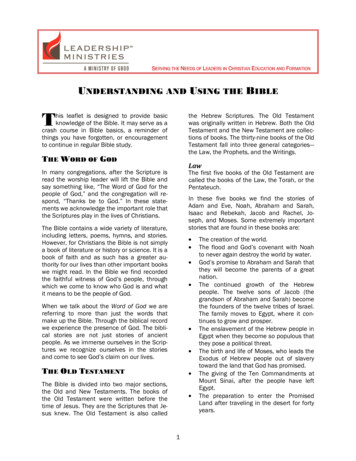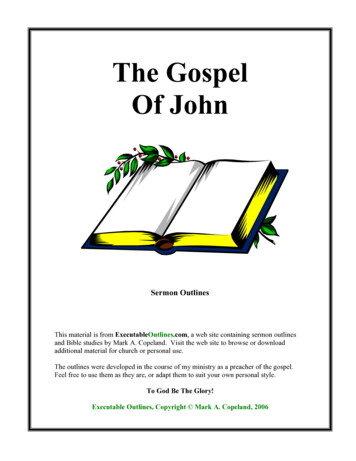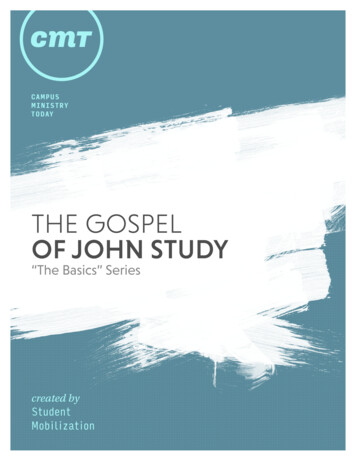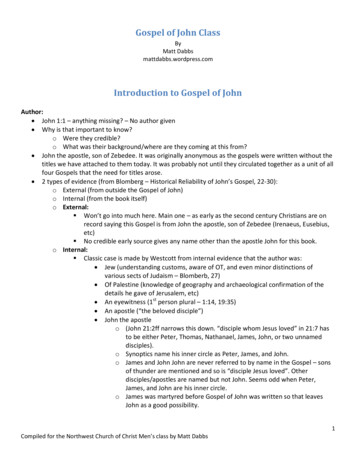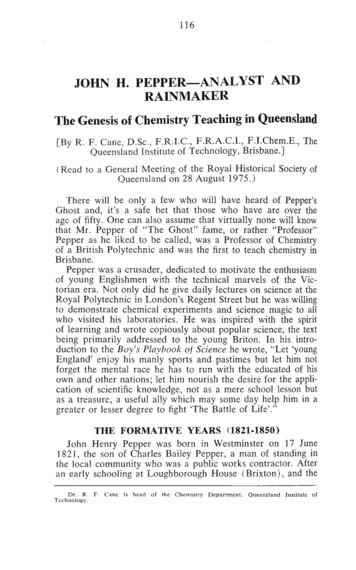
Transcription
116JOHN H. PEPPER—ANALYST ANDRAINMAKERThe Genesis of Chemistry Teaching m Queensland[By R. F. Cane, D.Sc, F.R.I.C, F.R.A.C.I., F.I.Chem.E., TheQueensland Institute of Technology, Brisbane.](Read to a General Meeting of the Royal Historical Society ofQueensland on 28 August 1975.)There will be only a few who wUl have heard of Pepper'sGhost and, it's a safe bet that those who have are over theage of fifty. One can also assume that vktually none wUl knowthat Mr. Pepper of "The Ghost" fame, or rather "Professor"Pepper as he liked to be called, was a Professor of Chemistryof a British Polytechnic and was the first to teach chemistry inBrisbane.Pepper was a crusader, dedicated to motivate the enthusiasmof young Englishmen with the technical marvels of the Victorian era. Not only did he give daily lectures on science at theRoyal Polytechnic in London's Regent Street but he was willingto demonstrate chemical experiments and science magic to aUwho visited his laboratories. He was inspired with the spkitof learning and wrote copiously about popular science, the textbeing primarily addressed to the young Briton. In his introduction to the Boy's Playbook of Science he wrote, "Let 'youngEngland' enjoy his manly sports and pastimes but let him notforget the mental race he has to run with the educated of hisown and other nations; let him nourish the desire for the application of scientific knowledge, not as a mere school lesson butas a treasure, a useful ally which may some day help him in agreater or lesser degree to fight 'The Battle of Life'."THE FORMATIVE YEARS (1821-1850)John Henry Pepper was born in Westminster on 17 June1821, the son of Charles Bailey Pepper, a man of standing inthe local community who was a public works contractor. Afteran early schooling at Loughborough House (Brixton), and theDr. R. F. Cane is head ot the Chemistry Department.Technology.Queensland Institute ot
117King's CoUege School (London), during which he became fascinated with the exploits of the blossoming Brkish science.Pepper extended his knowledge of chemistry by studying underJ. T. Cooper at the Russel Institution. Cooper' was a chemistof some eminence who helped to invent a special microscope,manufactured scientific apparatus for sale and investigated newchemical compounds. This training enabled Pepper, at the ageof 19, to be appointed assistant lecturer in chemistry at theGranger School of Medicine.In England at that time there was a strong movement tocompete wiih the growing scientific strength of Europe, particularly of Germany. Sir George Cayley, intensely interested inscience and engineering, was instrumental in the erection of aGallery of Arts and Science in London—having space forworking models, lecture theatres and laboratories. This exhibition gallery developed into the Royal Polytechnic, the opening of which on 3 August 1838 was the occasion of muchcelebration.The main aim of the Polytechnic was to show to the generalpublic by means of exhibitions and models, the advances beingmade in science, particularly British science. There were steamdriven printing presses, lens-grinding machines, a model dockyard, a diving beU in a large tank into which visitors (for 6d)descended below the water, and a variety of different machines,while on the lower floor, there was a working chemical laboratory. In addition to the technological museum, lectures on popular science were provided, as well as some training in "naturalphilosophy" and chemistry.As he was working in London, Pepper frequented the Polytechnic and in 1847, he gave his first lecture there. In themeantime, his interest in chemistry had increased, and at theearly age of 22, he was elected a Fellow of the Chemical Societyof London.In the following year (1848), Pepper was appointed Lecturerand Analytical Chemist at the Royal Polytechnic; an associationwith that institution which lasted over 20 years. Pepper workedin the chemistry laboratories giving demonstrations, indulgingin some chemical "magic" and delivering lectures. By invitationhe also lectured at the best English schools (Eton, Hayleybury, Harrow and Cheam) at which he intrigued and delightedhis young audiences by displays of chemical tricks and magic,intermixed with solid science of real educational merit. Pepperappears to have had a particular flair for what is now called"Youth Lectures"; there is no doubt that his extrovert personality always attracted large audiences. Indeed, the famousQuintin Hogg wrking to his mother from Eton stated "Pepper
USWe Int, O W Wm Wm mm %M SntFig. 1. Professor" Pepper of the Royal Polytechnic.the Polytechnic lecturer, is giving a weekly course of lecturesdown here, and I attend them, and I am going to try for theSchool prize, though it is an awful sap. There are five lecturesand ten questions for every lecture . . . The lectures are on
119electricity and he has every sort of apparatus on an enormousscale." Pepper's flair for the theatrical, backed by increasingpublic interest in his lectures, gained the attention of the Governors of the Polytechnic and, in 1852, he was made "HonoraryDirector and Professor". It was also the year in which hegave his only formal lecture to a learned society, the paper,"A new Test for Strychnine" was presented to the ChemicalSociety on 17 May, but never published.1852 is also important as the first time which Pepper becameassociated with Australia. He gave a lecture in London entkled"The Australian Gold Fields and the Best Means of Discriminating Gold from all other Metals". This lecture was later published as a smaU book. In this book he stated that "he recentiyhad the pleasure of conversing with an officer in charge of theAustraUan convicts". The outcome of this conversation wasPepper's exhortation, "Surely with our overgrown population,the good time has come at last . . . let the industrious pooremigrate and reap the just reward of their labour". In orderthat the poor could better recover their just reward in thecolonies, Pepper suggested they should not leave England without purchasing tents, coUapsible carts and gold-washingmachines. The book contained advertisements of such machines"of best class" at 3-10-0 constructed "as yet to leave eachmachine avaUable as a sea chest", collapsible carts folding uplike packing cases for 8/- and large emigrant tents with sleeping lofts for 8-10-0 each, a six foot high wire fence all aroundwas provided for 16/- extra. As the book sold for orUy 6d,there seems no doubt that the many advertisements provideda reasonable return to the author. His chemical knowledge ledhim to suggest that emigrants can distinguish gold from basemetals by heating samples, or by dissolving them in nitricacid. He also suggested that gold can be separated by amalgamation and boiling off the mercury on an iron shovel (a processhardly conducive to good health!— R.F.C).LONDON (1850-1878)The years between 1850 and 1870 must have been very fullones for John Pepper; he wrote no less than 11 books of popular science. These enjoyed considerable s.ales, were reprintedin America and even became prescribed school texts in Pennsylvania and Brooklyn. Sk Robert Hadfield was so impressedth.a.t he purchased a large number of copies and gave them toSheffield schools "with the object of encouraging boys to makeexperiments rather than to acquire knowledge merely by thereading of books". Perhaps Pepper's best-known books areThe Boy's Playbook of Science (1860), and The Playbook of
120Minerals (1861). These were preceded by a contribution toPeterson's Familiar Science (1851) and many others.During these years not only was his output of printed scienceprodigious but, additionally, he lectured and gave exhibitionsalmost daUy on a variety of topics. Electricity and light fascinated him. At one "show" he cooked pieces of meat acrossthe main hall of the Polytechnic by having two parabolic mirrors with a charcoal fi.re at the focus of one of them and achop at the focus of the other. During the wedding festivitiesof Albert, Prince of Wales, in 1863, he arranged a splendidillumination of Trafalgar Square and St. Paul's Cathedral witha special form of arc light. Of course, his main claim to famewas "Pepper's Ghost" shown for the first time on ChristmasEve, 1862, illustrating a scene from Dicken's Haunted Man.The optical iUusion of "The Ghost" took London by surprise,was an enormous success and, to a certain extent, was a meansof restoring the flagging finances of the Polytechnic. "Pepper'sGhost" was given a Royal performance at Windsor, visited morethan once by the Royal family (The Prince of Wales took hisbride to see it the week after their marriage), and shown onthe stage in London, Paris, New York, and elsewhere. Unfortunately, the proprietary status of the spectra was marred by afierce controversy over who had actuaUy invented the device.Pepper or a man caUed Dircks. Pepper claimed that he hadthought up the idea on reading Robinson's RecreativeMemoirs, of 1831, whereas Dirck claimed he had publicisedthe information before the British Association in 1858, based onhis patent of 1838. Because of the lucrative success of theapparition, claims to the ownership of the idea waxed furious.Dircks published a book"*. The Ghost as produced in the SpectraDrama, in which he described how he originated the schemeand how Pepper came to produce it. Nothing daunted. Pepperproduced a series of articles claiming his ownership of the mainidea. The outcome was a costly action by Dircks againstPepper in the Chancery Court before Lord Westbury, witnessesfor Pepper were Sir David Brewster and Sir Charles Wheatstone;two very eminent British scientists. The Lord Chancellor delivered his verdict in Pepper's favour but, even at the end ofthat decade, the argument was stiU raging. The controversycertainly brought Pepper's name before aU of London's reading public.Electricity was another of Pepper's interests. He was largelyresponsible for a banquet at the Polytechnic on 21 December1867 at which the Duke of WeUington "wkh many noblemenand scientific gentlemen in attendance" sent, by electric wire,a goodwill message to President Johnson of the United States.
121Pepper arranged the technicalities and, in person, brought thewires and telegraph keys to the seated personages. The messagetook 9i minutes from London to Washington and a reply wasreceived in 29 minutes. On both sides of the Atiantic the eventwas hailed as a notable achievement for science.Because of his increasing public activities and outspokencomment, towards the end of 1871, relations between Pepperand the directors of the Polytechnic became so strained thatThe Times, of London, printed an expression of hope that thedifference between the flamboyant Pepper and the directors"may yet be adjusted on a satisfactory basis''. The main areaof contention was the authority of the Board of the Polytechnicin relation to Pepper's autonomy. Apparentiy the negotiationswere not successful for, in March 1872, he left the Polytechnicand transferred his exhibits elsewhere. In 1875 his name wasremoved from the Fellows list of the Chemical Society and afew years later he left England.After severing connection with the academic world. Pepperentered wholeheartedly into the world of showmanship and thetheatre. He had a successful tour of America and arrived inAustraUa in 1879.VICTORIA AND NEW SOUTH WALES (1879-1880)John Pepper, his wife (Mary Ann, aged 48) and son (H.W.,aged 23) arrived in Melbourne on 8 July 1879 on board theLusitania (3,825 tons) and, although he was Usted as "of nooccupation", three days later a Grand Reception was given tohim in the Atheneum Hall. At the reception the GovernmentAnalyst announced that Pepper had come out at the invitationof a score of gentlemen anxious to hear more about science andwho had formed a lecture association. (This statement is unlikely to have been true—R.F.C) His arrival "was an eventthat was haUed with much satisfaction by all classes of ourcolonial communky . . . Wonderful optical illusions, he invented and brought out 'The Ghost', the metempsychosis, themagic limner, wonderful dissolving views, and scenes by theoxyhydrogen microscope".'"Pepper gave his first lecture at St. George's Hall on 12 July 1879and the Age (14.7.79) wrote of his appearance as "The Eventof the Season". The Argus (14.7.79) related that "he had beendelighting audiences with his lucid explanation" and "It wasone of the best scientific exihibitions that a Melbourne audiencehad seen. . . . The ease, unaffected and pleasant manner ofPepper's exposition of scientific facts contained, in themselves,the promises of many future successes". Nevertheless after a
122Fig. 2. — J. H. Pepper in Melbourne (Ref. 10)."The Ghost" and scenes by means of the oxyhydrogen lamp,his attractions seemed to have lost their interest and his finalperformance on Saturday 3 August was given scant attention bythe local Press.Pepper then moved to Sydney and put on a series of somewhat grander performances at the School of Arts between September and the end of 1879. At his first performance, he wasgreeted by "a tremendous and enthusiastic audience who expressed delight and amazement at the novel and beautiful entertainment"."The performances were much the same as those in Melbourne—dancing skeletons, appearing and disappearing ghosts andapparitions, a variety of optical illusions and chemical magic.Pepper was described in the Press as "one of the scientificgiants of the present age" and "the large audience is flatteringto the professor's feelings and to the development of sciencein the antipodes".' His optical illusions included turning adog into a string of sausages, a bowl of oranges into tins ofmarmalade and causing flowers to grow from an empty pot.A critique stated, "It is hardly possible to imagine an entertainment more taking or more interesting and, at the sametime, so full of really useful information as that given by Professor Pepper"."His reinactment of the ghost of the murdered ex-convictFrederick Fisher had the same awesome effect on Sydney audiences as the original "Ghost" in London. Nevertheless, afterabout a month his audience began to fall off and the Herald ofOctober 1879 reported only "a tolerably good audience to thenew programme". Pepper's run of the spectacular finished inSydney on 4 November 1879, after 41 performances.
123Fig. 3.- J . H. Pepper in Sydney.Illustrated Sydney News, 29.11.79.Undaunted by only mediocre interest towards the end of hisseason. Pepper, on the following week, appeared at the Victoria Theatre in Sydney as playwright, producer and actor inthe romantic drama Hermes and the Alchymist, the latter whocould make diamonds and the former possessing the eUxirof life. It was not a success—a critique stated that, "It iscertainly an original drama, for nothing like it has ever beenput on the Victorian stage before . . . act after act finishedamid profound sUence . . . or else with the accompaniment ofa hiss"."* It played for a few weeks then was followed by ahumorous sketch entitled The Red Lion Inn or The MissingGhosts. Towards the end of November, Pepper announced thathe was ready to deliver a series of daytime lectures if therewere enough subscriptions at 1 guinea for six lectures. Hefinished his Sydney season on 12 December 1879 and thenvisited Bathurst, Orange, Goulburn' and other country townsduring the New Year, 1880. He then went on to Tasmania." A few months later, in AprU 1880, Pepper was back again inMelbourne''' starting a series of secular sermons on astronomyat St. George's Hall, prior to departing to London where heengaged some staff and returned to Australia.SOUTH AUSTRALIA (1880-1881)Both The South Australian Register and The South Australian Advertiser carried prominent announcements of a series
124of scientific lectures to be given by Pepper at the Academy ofMusic commencing on 30 August. In addition, Pepper wasadvertised as "from the Royal Polytechnic" and his "wonderfulinteresting experiments" will be shown "under the auspicesof the leading citizens of Adelaide". A further announcement"*stated that the Minister of Education had made special arrangements for Pepper to deliver a course of lectures to school pupilsand their teachers.Pepper and his entourage arrived in Adelaide on 28 August1880 and considerable prominence was given to his first lectureat which the Governor, his family and suite were present; adescription of the evening occupied nearly a full column ofthe Press.' For the whole of September daily advertisements,letters and reports maintained a lively public interest. The styleof some reports leads one to surmise that the more laudatorymight in fact, have been written by members of Pepper's staff.(The writer of this paper has counted no less than 210 newspaper advertisements during Pepper's South Australian season!)In addition to lectures to school children. Pepper put ona "Grand Scientific Military Festival" " which, in turn, receiveda very good press. The situation was very promising whenPepper announced that his final lecture (in the first series)would be given on 11 September, as he was going up-countryon tour. During the ensuing fortnight, he visited Kapunda,Gawler and Wallaroo.Pepper returned to Adelaide in October to start his theatricalentertainments; he had already made a considerable impressionon Adelaide audiences by his scientific lectures. His performances were given in Garner's Theatre and were similar tothose given previously in Melbourne and Sydney. The smoothrunning of "the show" was interrupted by a Supreme Courtaction by an ex-employee, who stated that Pepper had engagedhim in London under contract for 14 months but refused topay his wages. Pepper claimed that the man (John Saunders)was not entitled to wages as he "was persistently disobedientand insubordinate and had misconducted himself". Pepperwas, no doubt, affronted by the whole affair, particularly asSaunders had caused Pepper to be openly arrested prior to thecase and he had to be "bailed out". Nevertheless, Pepper lostthe case and was required to pay, with costs.Pepper was again lecturing in November, under the auspicesof the Education Department, giving benefit entertainments forthe Glenelg Institute and the City Mission, ' followed by afurther country tour and a second series of theatricals at Garner'sTheatre. On New Year's Day 1881, the South AustralianRegister carried a leading article, "Royal Polytechnic for Ade-
125laide" in which it was stated that Professor Pepper had proposedthe estabUshment of an exhibition gallery and polytechnicsunilar to that in London and that, further. Pepper, "if encouraged", would be wiUing to provide lectures and exhibits.His theatre performances ceased during the first week in January ostensibly because of poor audiences, caused by hotweather. However, it also corresponded with a further courtappearance by Pepper "* for not paying the wages of his staff.The proceedings were enlivened by Pepper arguing with theplaintiff's counsel and Pepper's being accused of stealing (andopening) another person's letter. The case was dismissed because k was shown that the plaintiff was planning "to set upa rival show". Pepper's shows were again on stage in May 1881, this timeunder the auspices of the Chamber of Manufacturers. Thesubscription lectures on "Light", "Heat", and "Electricity",were especially aimed at the working classes but, in spke oflurid advertisements plus demonstrations of the loud speakingtelephone and phonograph, attendances were not good and hisfinal Adelaide lecture was given on 2 June, 1881. He thendeparted for Brisbane.BRISBANE (1881-1889)In mid-July The Telegraph ' stated that Professor Pepperwould be appearing for a short season at the Theatre Royalstarting on July 23. As usual his appearance was heraldedby daily extravagant advertisements and press notes. On hisopening day The Telegraph stated that "This celebrity" will"not present the mere dry bones of science but clothes it inso fascinating garb that his patrons cannot fail to be delighted". Unfortunately, at this time, Brisbane people had tochoose between Professor Pepper and the marvels of scienceand Professor Anderson, "The Great Wizard of the North",with his "World of Magic". The latter, as weU as beheadingladies and turning boys into pumps, cajoled his audiences withhandsome gkts of "suites of furniture, horses, coffee sets andgold watches".25By the end of the following week, competition between thetwo professors resulted in each displaying expensive half columnadvertisements, Anderson giving away pianos, horses and silvertea services, while Pepper, under the patronage of the Governor, the Chief Justice and the Mayor, was "plunging hishands into boUing water and red-hot lead". He maintained hisinterest in the scientific education of the young and schoolswere invited to his lectures.
126After visits to Toowoomba and other towns in the Downs,'"Pepper returned to Brisbane and late in August gave a seriesof lectures on astronomy. These were given at the PresbyterianCollege Divinity Hall in Creek Street. At the same time hewas presenting repeat lectures in the new Minores Hall inMorwitch's Buildings in Queen Street. The church lecturesdealt with the structure of the solar system illustrated by slidesof earth, planets and solar eclipses, whereas the "Course ofScience Festivals"- ' in Morwitch's Buildings were the "oldfaithfuls" of lights, optics, electricity and heat; at one guinea forthe series.In September, Pepper reverted to science magic with demonstrations of "The Ghost" and other illusions, prior to a furthercountry tour and a return to Brisbane in the New Year withtwo more subscription lecture series. Pepper was undecidedwhether to remain in Brisbane and advertisements said thatsoon "The Ghost" will vanish forever." He then made twocountry tours visiting Toowoomba, Ipswich and other places.The Ipswich tour was such a success that he again was givingsubscription lectures in Brisbane in the New Year of 1882,"and demonstrating the electric light at the Queensland NationalAssociation exhibition. ''In the summer of 1882, south-east Queensland was sufferingfrom a prolonged dry period and Brisbane was subject to "terrible heat". Towards the end of January, an announcementwas made that Professor Pepper was going to draw rain fromthe clouds by means of a gigantic kite. Front page advertisements appeared in The Brisbane Courier announcing "Tappingthe Clouds" together with explosions of dynamite and gunpowder and discharge of cannon. Subsequent advertisementsstated— "TAPPING THE CLOUDSorRAINMAKINGAnd several interesting Illustrations of Atmospheric PhenomenaPOWERFUL ROCKETSCAPTIVE AIR BALLOONSTo conduct electricity to or from the CloudsTHREE ENORMOUS KITES"The newspapers noted that Pepper had started experimentingwith a 20ft. kite at Eagle Farm race course. Unfortunately, even
127with six men to control the system, k was too un wieldly andhad to be reduced in size. Pepper had been given, or lent, nearlythree mUes of steel wire, ten swivel guns, some powerful rocketsfrom the H.M.S. Cormorant, much rope, a land mine, andnearly a hundred-weight of gunpowder. A footnote to his advertisement stated that "every care will be taken for the safetyof the audience". In addition. Pepper had suggested a largebonfire arranged to produce much smoke to enhance the prospects of rain production, the concept did indeed have somescientific basis. Pepper proposed, by means of the kke, to raisea land mine to cloud level. An electrical path was then providedfrom the kite to earth by means of the steel wire and he wasto attempt to explode the mine in mid-air. He was going "toalter the electrical condkions of the clouds" and providenucleation in the aftermath of the explosion. The black smokewould provide further "seeding".By the eventful day (4.8.82), the Brisbane public hadreached a great pitch of excitement by the Press articles andlurid advertisements. Almost 700 people arrived at Eagle Farmand paid their entrance fee.The cannons were fired, the dynamite charges were exploded,two of the rockets had dangerous horizontal flights, one overthe fence which exploded outside the arena and the other justmissing the crowd on the other side. Although many attemptswere made, the scientific kite never left the ground, accompanied by hoots from the crowd. Eventually members of theaudience attempted to fly the device but without success. Theill-humour of the crowd was diverted by other performancesand the whole affair dissolved into a general fiesta. One ofPepper's assistants gives a first hand account."*""The Ptofessor had the kke constmcted so that itcould be easily conveyed through the bush. It was muchtoo heavy even for two smart horses and we could notget the kite to rise higher than 30 or 40 yards. This partof the experiment was last given up as a failure.The whole of the guns were loaded; then the coursewas cleared, and after firing the mine containing thedynamite, I fired the guns in rapid succession. When Ifired the tenth gun I was astonished to see the gun disappear, and to hear a few seconds afterwards a crash onthe roof of the grandstand about 300 yards away. The gunhad simply burst and blown to pieces. Later on I discovered the cause of this. We had left some spare powderin charge of a man; this man had gone away somewhere,and during his absence some of the youngsters had gothold of the pow.der, and filled the gun right up to the
128muzzle. They did this while I was busy with the mme.Considering that I was standing withm a foot ot the gun,which was surrounded by a crowd of people and that thegun literally blew to pieces, it was marvellous that notone of us received a scratch. That was our first and lasttrial at tapping the clouds for ram."Pepper wrote" and explained that, by using steel for theframework he had erred in making it too heavy. After announcing that he was raising a subscription list for 50 guineas tocontinue the work with bamboo frameworks, nothing furtherwas ever reported. Ironically, rain poured down during the following week and parts of Brisbane were badly flooded. Thefailure of the demonstration was the basis Of considerablejibing, including much punning on the word "pepper". Nothing daunted, soon after Pepper was again providingsubscription, lectures at the Albert Hall and giving demonstrations "of a wonderful invention called the gramophone". 'At the third lecture the Courier reported,'' "the audience wasnot numerous and the lecturer was late". On. the subject of"Gold and the future Prosperity of Queensland", there wasvociferous disagreement between Pepper and some of the audience. The lecture was not completed.Nevertheless, on the following week, The Courier carriedan announcement that Pepper, under the auspices of theQueensland Board of Education was giving evening courses inelementary science at various schools. These were to be givenon regular days each week at Toowong, Petrie Terrace, SouthBrisbane, West End, Sandgate, and elsewhere. There was morethan one course, each costing 10/- for six lectures. This wasnearly a century ago and travelling between suburbs on aregular schedule at night every working day of the week wasquite a feat for a man of 61. Lectures were well attended, theseries sponsored by the South Brisbane Mechanics Institutewas a notable success and the Head Master of the LeichhardtStreet School suggested that Pepper should write a scienceprimer for use, and this he did." It was at a crowded Leichhardt Street School meeting on 29April 1882 that Pepper announced that he intended formingclasses to teach chemistry arid these were to be held at hislaboratory at 206 Queen Street. Next week there appeared aPress announcement''* that Professor Pepper's laboratory wasopen for morning and evening classes for teaching practicalchemistry, performing analyses and experimentation. This was,I believe, the first formal teaching of chemistry in Queenslandand marks an important date in the education history of thisState.
129p EOFESSORP 1 P PEE'SLABORATORY,206 QUEEN-STREET, BRISBANE,I S N O W O P E N .MORNING A -D E T E N I N G SCIENCE CLASSES,for TeachingPRACTICAL CHEMISTRYand thePHYSICALSCIENCES,are being formed for Ladies and Gentlemen.ANALYSES performed, and Advice given andExperiments made for the improvement ofManufactures, and also for intending Patentees.ODcnlOtoL a n d 7 t o 9 p , m 5682Fig. 4.— The first Teaching of Chemistry in Queensland (Ret. 44).Some of his classes must have been lively ones. In May,the Headmaster of Kangaroo Point School wrote to the UnderSecretary of Public Instruction about disorderly conduct during Pepper's classes. When the Headmaster remonstrated aboutbroken windows he "was informed in very forcible terms,'They would heave a rock at me' if I interfered. ProfessorPepper's assistants do not think it part of their duty to keeporder".'' By the beginning of 1883, Pepper had given up "the worldof entertainment" and concerned himself with science education. About that time the Brisbane School of Arts in Ann St.,had decided to diversify its teaching to include carpentry,chemistry and other practical arts. The chemistry classes wereto be "under the dkectorship of Professor Pepper and his son".Although the initial years were successful, by 1885 attendances had decreased so much that the half-yearly meeting ofthe CouncU of the School of Arts decided that "as no advantagewas taken by the general public of the chemistry class, thecommittee have discontinued it untU better support isafforded".'' This action brought an angry response from Pepperthat, as he had paid 35 for chemicals, he must be doingsomething. Furthermore the Governor, his two sons and secretary had already attended the course and this should indicate
130, "THE SERVANTS' HOME", ANN STREET , f p m i s e s as they were when purchased in 1873.Fig. 5. —
RAINMAKER The Genesis of Chemistry Teaching m Queensland [By R. F. Cane, D.Sc, F.R.I.C, F.R.A.C.I., F.I.Chem.E., The Queensland Institute of Technology, Brisbane.] (Read to a General Meeting of the Royal Historical Society of Queensland on 28 August 1975.) There will be only a fe wUw wh havl oe heard of Pepper's

